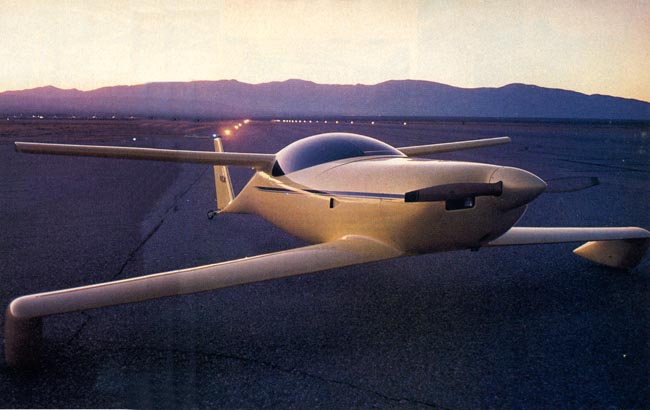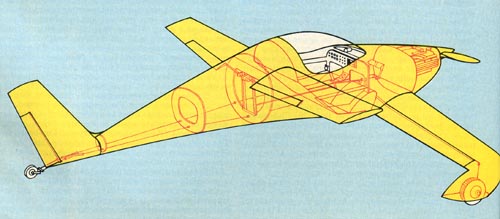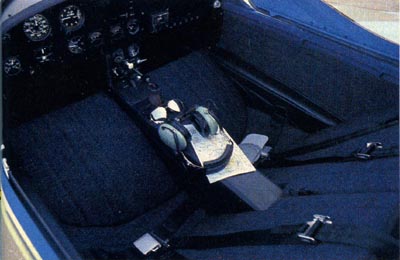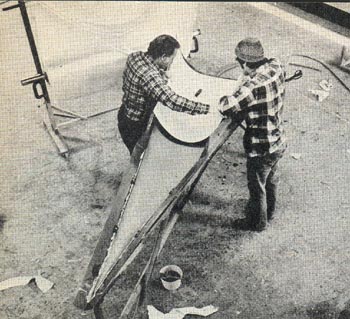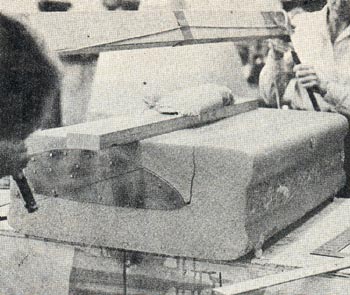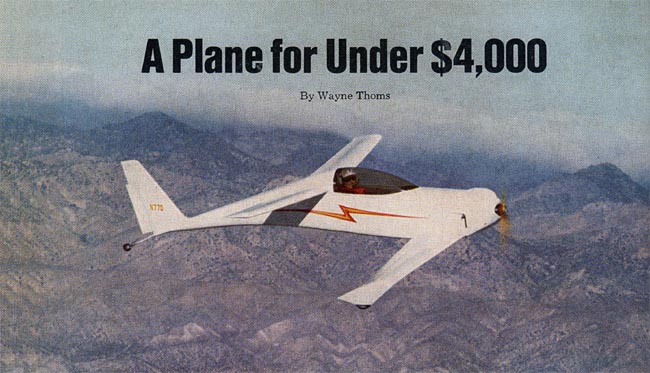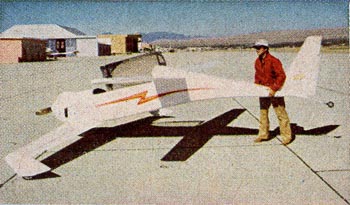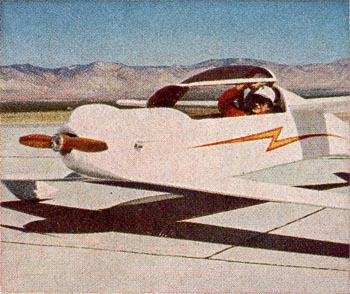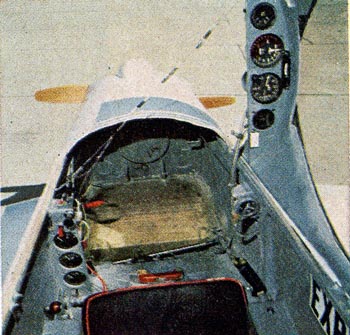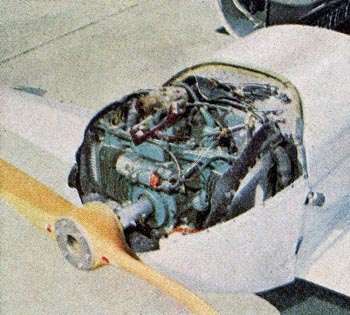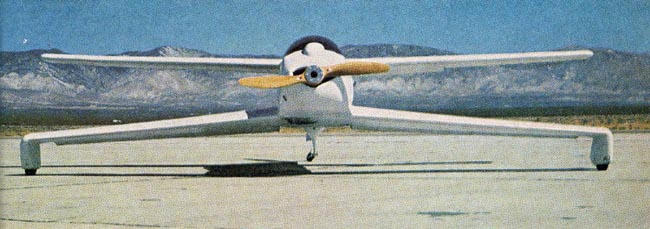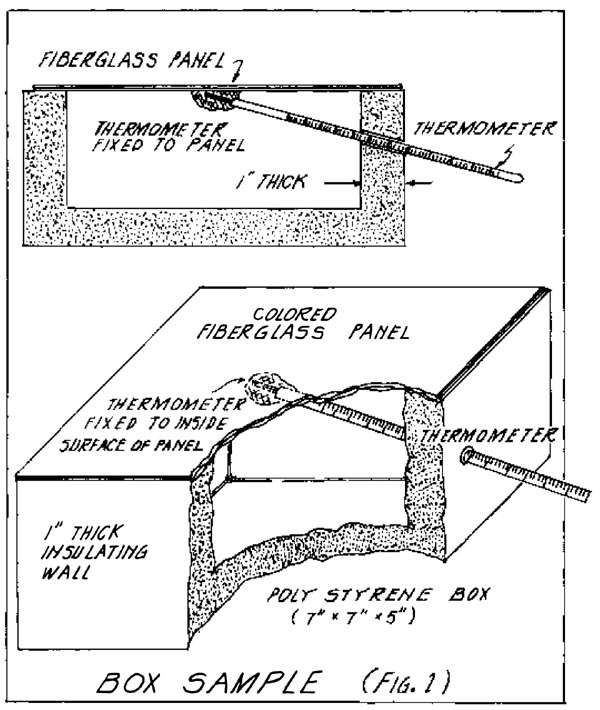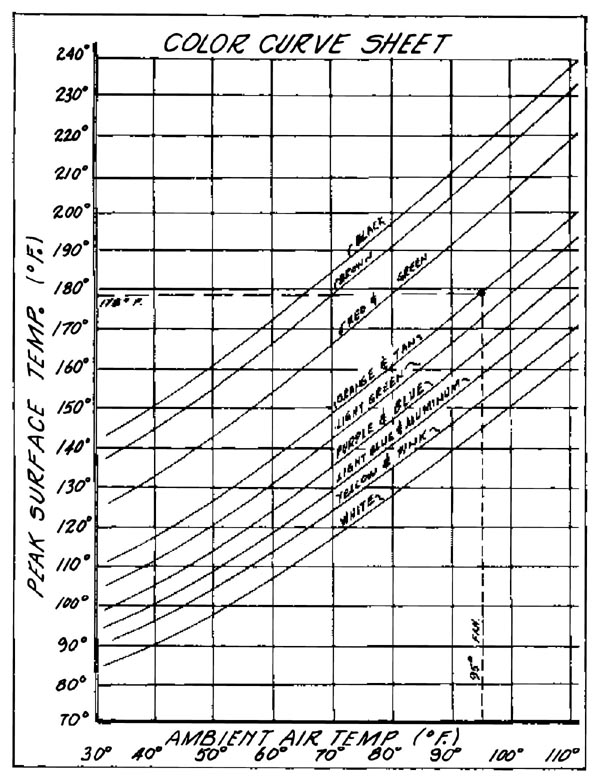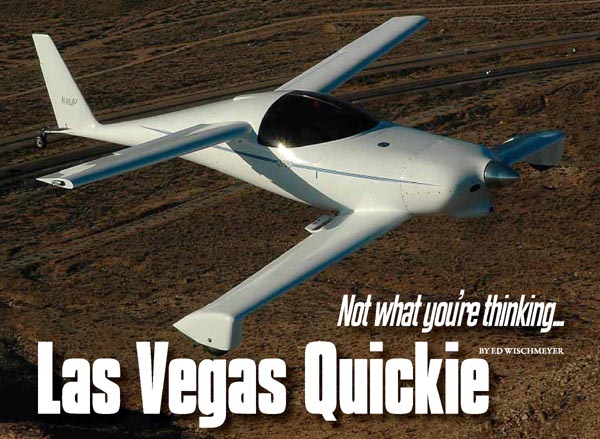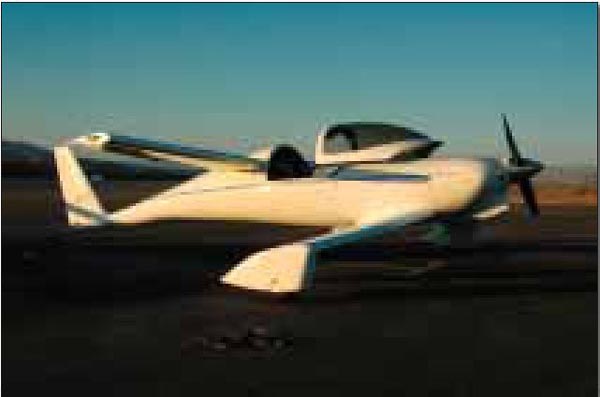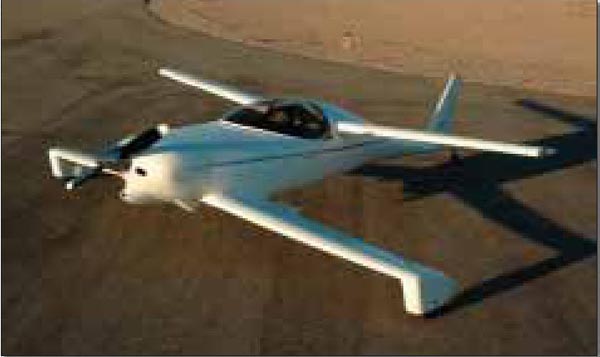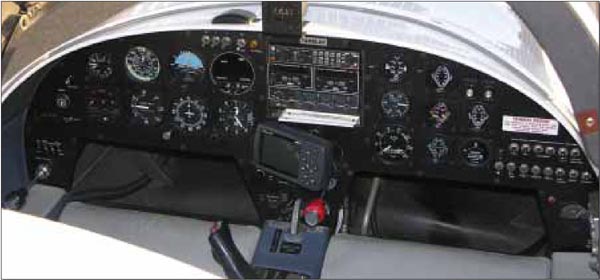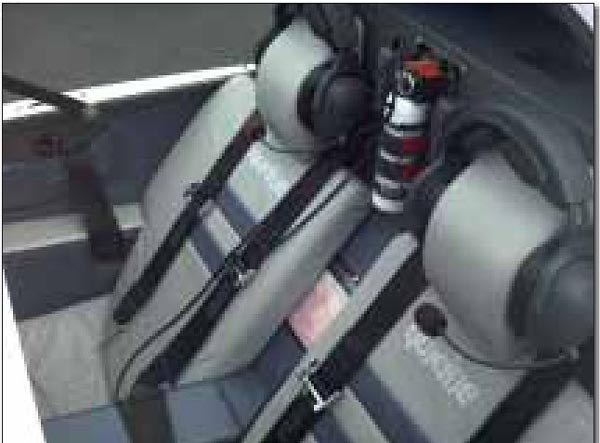- Details
-
Category: Magazine Articles
-
Published: Thursday, 09 December 2010 11:53
-
Written by Don and Julia Downie
-
Hits: 38296
Chapter 6
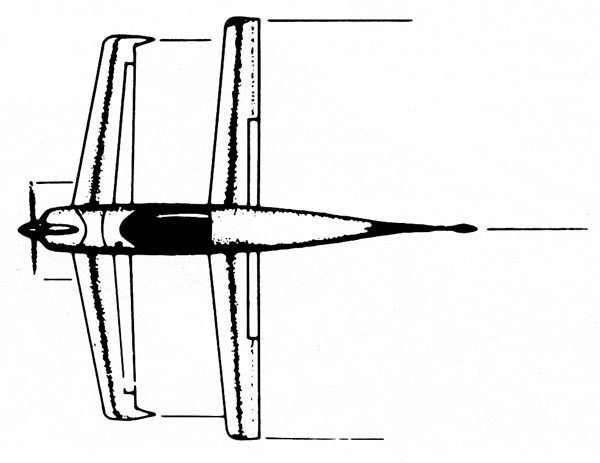
The Power to Go On
Reliable, affordable, efficient powerplants have been the goal of aircraft designers since day one. The history of aviation has many examples of fine, innovative designs that literally never got off the ground because a suitable powerplant was not available at the time the design was developed.
There was one notable exception where two designers searched first for a suitable engine and then had an airframe designed to fit it. And this is where Rutan entered the picture.
QUICKIE: THE ENGINE CAME FIRST
The amazing Quickie (Fig. 6-1) is the brainstorm of Gene Sheehan and Tom Jewett, two development engineers who searched nearly four years to find a reliable gasoline engine in the 12 to 25-hp range with sufficient power for an efficient, single-place sport plane.
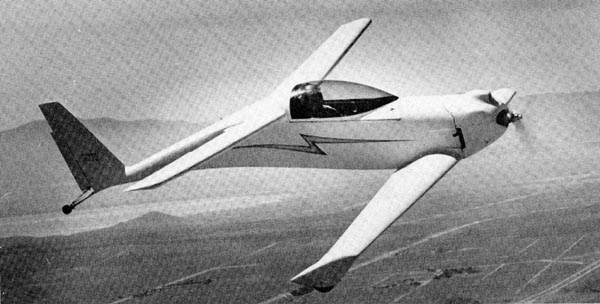 |
| Fig. 6-1. Quickie in flight near Mojave. Gene Sheehan is at the controls. N77Q is the original prototype and is being used as a test bed for new improvements. |
Tom Jewett (Fig. 6-2) was a flight test engineer on the Rockwell B-i bomber. He spent his entire career in flight testing new aircraft, ranging from homebuilts to jets. He was a graduate engineer from Ohio State University. Subsequent to the Quickie project, Jewett was killed at Mojave in the crash of Free Enterprise, a design under development for an around-the-world flight attempt. (See Chapter 15.)
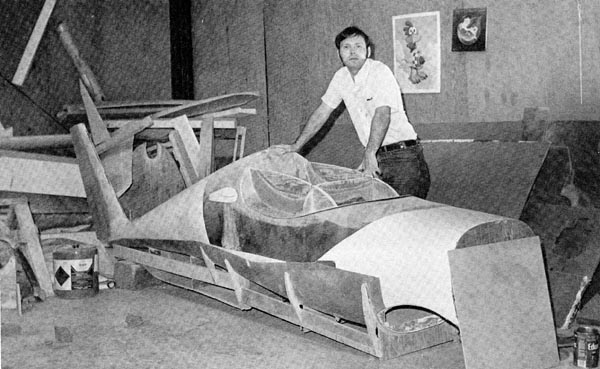 |
| Fig. 6-2. Tom Jewett stands beside the original mold used to form the Quickie fuselage. The cabin is large enough for a 66 ”, 220-lb. pilot. |
Gene Sheehan had worked in the aerospace industry since 1964 and with homebuilt aircraft since 1973. He was involved with several home- built projects, including the BD-4, a helicopter, a gyrocopter, and a BD-5. A former University of Texas student, he is also a private pilot. Sheehan has continued with the Quickie and the two-place Q2 project since Jewett’s death.
Since engine development is critical to any new airframe, it came ahead of the Quickie’s configuration. Gene and Tom were purposely secretive in their engine project, not wanting to follow the path of some other developers who put plans and kits on sale before the systems had ever flown or been proven.
“This is not the policy of our little skunk works at the Mojave Airport,” explained the developers of the Quickie in their initial brochure. “The development of the Quickie was one of the best kept secrets in aviation. Until its first flight late in 1977, its existence was known only to a handful of people.”
The “skunk works” refers back to famed Lockheed designer Kelly Johnson’s super-secret skunk works that developed the P-80, the famed U-2, and the Mach 3 SR-71 Blackbird. Johnson was noted for a minimum of engineering drawing and a maximum of prototype building to cut time and cost in new aircraft development.
The Quickie story really goes back to early 1975 when Gene and Tom began looking for a small, efficient, reliable engine. The search included two-stroke and four-stroke engines used in chain- saws, garden tractors, motorcycles and automobiles. The search was frustrating because lightweight, powerful engines lacked reliability and the ones that had proven reliability were either too heavy or did not develop enough power.
SEARCH FOR AN ENGINE
The search for a suitable engine was outlined by the two engineers in their company brochure:
The origin of the Quickie began with the search for an engine that required over two years. Until it was completed, no serious thought was given as to what the aircraft should look like because the aircraft was to be designed around the engine.
The requirements for the engine were simple enough:
12 hp to 25 hp.
Lightweight.
Small size.
Low fuel consumption.
Reliable, reliable, reliable.
Many different types of engines were evaluated prior to making that selection.
Two Stroke: These engines have several desirable features including high power, light weight, and few moving parts. The disadvantages include poor fuel economy, high rpm, high vibration level, poor mixture deviation tolerance, and questionable reliability for an aircraft application. Several small aircraft are using the McCulloch chain saw engine. It is interesting to note that all of these airplanes are either powered hang gliders or powered sailplanes, and not intended for cross-country use. Two- strokes are very mixture conscious; throttle back with the mixture leaned, descend and forget to richen the mixture, and as soon as power is added the engine is likely to seize. Failing to lean the mixture at altitude, however, may lead to plug fouling. Most dirt bikes powered by two-stroke engines have two spark plugs for each cylinder so that the rider can switch plug wires when the first one fouls.
Rotaries: The small Sach’s wankel rotary engine has many of the desirable features of a two- stroke, and it is certainly smooth running. However, these engines have had seal problems when run for long periods at high power settings, and the fuel consumption characteristics are poor in the rpm range necessary for good propeller efficiency. Besides,the engine is no longer produced.
Four-Stroke: These engines are the best ones for aircraft use. They have a good fuel economy and tend to be very reliable. In the low horsepower examples, however, they tend to be heavy, or to require a high rpm, in order to produce sufficient power. One of the four-stroke engines that Quickie Enterprises tested was a Honda CB175 motorcycle engine. Initially, it was too heavy, but after removing the transmission with a bandsaw and deleting all other non-essential parts, the weight was reduced to about 65 lbs. This engine produced about 18 hp at near 9,000 rpm. While Honda engines have a reputation for being very reliable, the drastic surgery required to reduce size and weight could very well have weakened the crankcase and, therefore, reduced the reliability.
One might ask at this point why not use a reduction drive system with a light weight, high rpm, four-stroke or two-stroke engine? There are several reasons not to do this, including complexity, cost, and torsional vibration. Given enough time, money, talent, and luck, these problems can be overcome. Often, however, the solutions only complicate the aircraft further. For example, a clutch is often used to solve the torsional resonance problem, but then the engine must use an electric starter, which adds about 25 lbs. of weight.
Volkswagen Engines: A number of home- built aircraft have flown using VW engines. However, a stock VW typically requires considerably more maintenance than a normal aircraft engine. This is probably because few automobile or motorcycle engines are designed for the type of continuous, high speed operation necessary for an aircraft.
Industrial Engines: These engines tend to be very reliable, but also heavy. Most are designed to run near rated power for extended periods and usually are so dependable that oil temperature and oil pressure gauges are omitted. They have reasonable fuel consumption and frequently operate under extremely harsh conditions. Until recently, they were prohibitively heavy, and the single cylinder models have excessive vibration for an aircraft.
The engine selected is a four-stroke, horizontally opposed, two-cylinder, direct drive type used in various industrial applications at a continuous 3,600 rpm (Fig. 6-3).
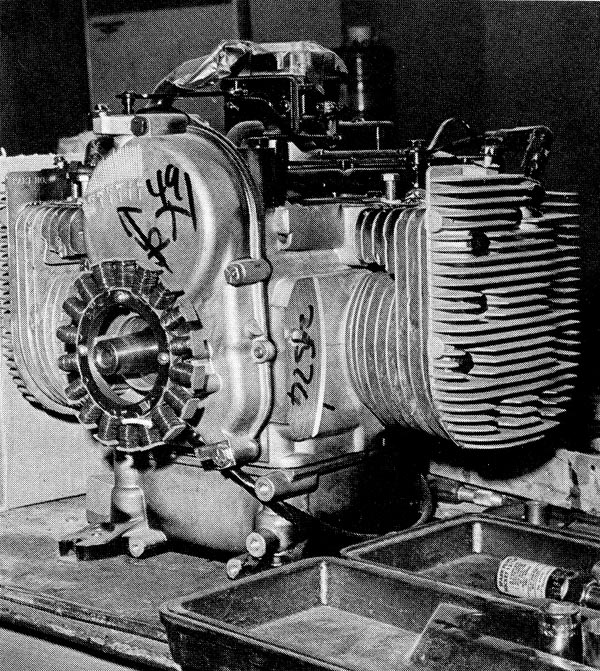 |
| Fig. 6-3. Onan engine on a bench at the Quickie factory awaiting modifications. |
The Onan Company has made over 1,000,000 two cylinder, horizontally-opposed, four-stroke direct drive engines in the last thirty years for applications from electric generator sets to snow plows. They recently introduced some aluminum versions of their cast iron series of engines. These aluminum engines weigh 98-106 lbs. in the stock configurations, some 50 lbs. lighter than their cast iron counterparts.
After careful examination, it was determined that we would reduce the weight to slightly more than 70 lbs. dry. While this may seem excessive for the produced 18 hp, they are very well built. Further, if the aircraft is carefully designed around the engine as was the Quickie, the results are most satisfying.
Some design features are as follows:
Horsepower - 18@3,600 rpm
Type - 2-cylinder, horizizontally opposed, four-stroke
Bore - 3.250”
Stroke - 2.875”
Displacement - 47.7 cubic inches
Compression - 6.6:1
The manufacturer recommends up to 1,000 hours between major overhauls for a normal industrial application. At this time, there is not enough data to state what the TBO in an aircraft application for a Quickie engine will be. However, it should be noted that in comparison with most industrial applications, the aircraft environment is cleaner and owner maintenance more regular.
Much testing has been accomplished in the areas of induction, exhaust, cooling, mounting, ignition system, and the engine airframe compatibility. The result of all this testing is an engine specifically intended for installation in the Quickie. It is definitely not the same engine one can buy from the local Onan dealer (Fig. 6-4).
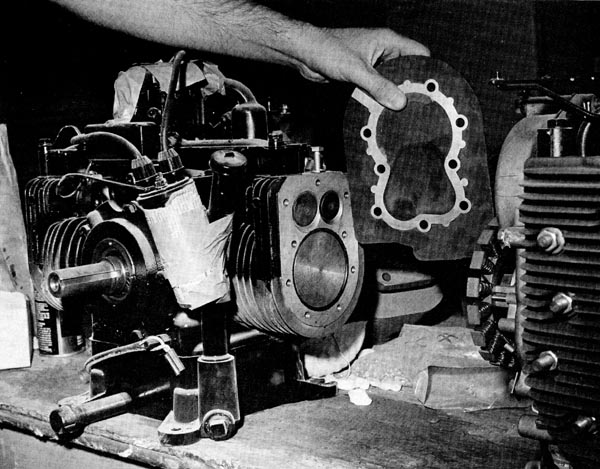 |
| Fig. 6-4. Onan engine with Quickie modifications ready for delivery to consumers. |
Only after the basic engine research and testing was well in hand did Gene Sheehan and Tom Jewett approach Burt Rutan, an old friend, to develop an airframe tailored around the Onan engine. Rutan was impressed by the demonstrated reliability of the engine and began putting lines on drafting paper. Early attempts were unsatisfactory because a low enough drag in a conventional or VariEze configuration would require a retractable gear with its associated weight and complexity problems. Most pusher configurations had only a narrow range of pilot weights.
Rutan finally came up with a novel tractor canard tailless “biplane” configuration (Fig. 6-5). The pilot sits near the center of gravity (Fig. 6-6). The combined canard and landing gear has low drag and saves both weight and complexity. This compactness lends itself to a “glue together” airplane that saves weight on wing attachments. Full-span elevator/flaps went on the canard with inboard ailerons on the rear wing. Originally the tailwheel fairing was the only rudder.
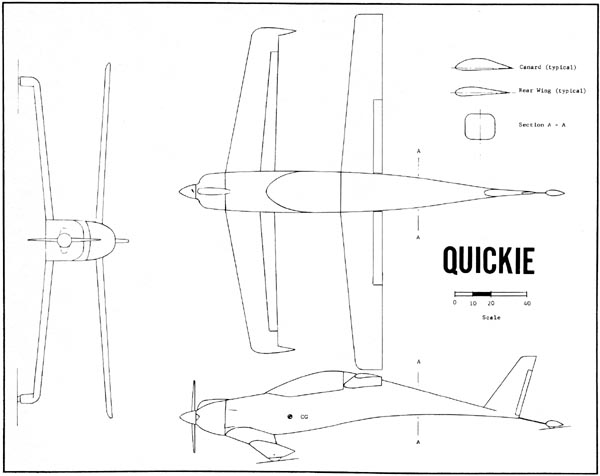 |
| Fig. 6-5. Three-view drawing of final Quickie configuration. (courtesy Quickie Aircraft Corp.) |
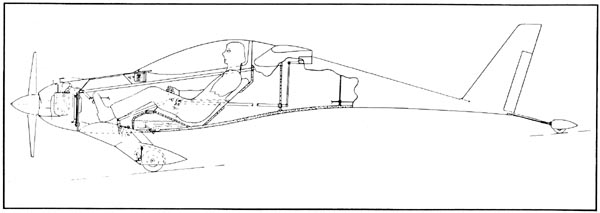 |
| Fig. 6-6. Cutaway drawing of the Quickie sideview. (courtesy Quickie Aircraft Corp.) |
Once the concept was established, a detailed plane was agreed upon. Tom Jewett and Burt Rutan did the detailed design while Gene Sheehan continued engine development. Most of the actual construction was done by Gene who had no prior experience with composite construction. This was a simple way to prove out the concept that the Quickie could be put together successfully by a first-time builder.
The construction phase took just two months. All three developers, Burt, Tom and Gene, flew N77Q on the first day after completion (Fig. 6-7). Then followed a five-month flight test program to assure that the unusual configuration, coupled with a new-to-aviation engine, would do the job.
Sales of the Quickie kit increased steadily. Shortly after the kit program began, the Quickie received the coveted Outstanding New Design award from the Experimental Aircraft Association (EAA) at the annual EAA Oshkosh, Wisconsin Fly-in. In presenting Quickie Aircraft Corporation with the award, EAA stated that the pioneering of the Onan engine together with an exceptionally efficient aircraft design in order to bring the cost of ownership and the cost of flying down to an affordable level represented a significant breakthrough. As this book went to press, Quickie Aircraft Corp. was no longer in business.
FLIGHT TO OSHKOSH
The trip to Oshkosh was described in the newsletter as follows:
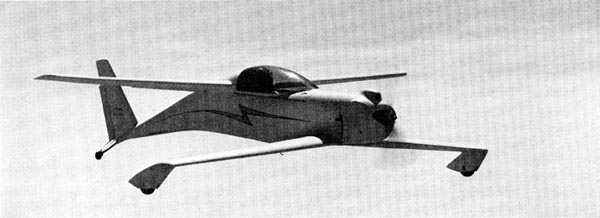 |
| Fig. 6-7. Unusual configuration of the Quickie shows up in this formation photo taken near Mojave, California, with Gene Sheehan at the controls. |
The Quickie was the lightest and lowest horsepower aircraft to fly to Oshkosh in 1978. We (Sheehan and Jewett) firmly believe that any aircraft which is not flown cross country to Oshkosh should not be offered for sale to the general public as an aircraft.
Our trip was spread over 2½ days, with overnight stops in Albuquerque, New Mexico and Kansas City, Missouri. The 2,025 miles were covered in about 19 hours (against the proverbial headwinds!) while averaging 65.1 mpg, also a record. That means that the trip cost us about $30 in gas and one quart of oil! The takeoff from Albuquerque was made at a density altitude of 7,000’. The highest altitude reached was 13,500’ west of Gallup, New Mexico. The normal cruise altitude was 7-8, 000’.
The trip was both routine and uneventful. Our biggest problem was minimizing the time spent on the ground when we stopped for gas. Usually we had to spend at least 30 minutes talking to the crowd that invariably gathered. In Dalhart, Texas, we had to wait an additional 30 minutes so that the line girl could go home and get her camera.
For a companion aircraft, we took along a Grumman Trainer. We had originally intended to use a Cessna 150 for the flight, but found that it wouldn’t keep up with the Quickie! The Grumman is about five knots faster than the Quickie and made a good companion aircraft.
We arrived at Oshkosh two days before the fly-in started so we could relax and take a short vacation. Wishful thinking! From the time we touched down until we left, we were surrounded by people wanting to see the aircraft and ask questions.
It was not unusual during the week at Oshkosh to find a crowd four people deep surrounding both the Quickie on the flight line and our booth in the main exhibit building (in fact, some people complained that they couldn’t find our booth).
Gene, Tom and Burt gave forums on the Quickie on both Monday and Friday. The crowd estimate on Monday was over 900 people. As a result, the forums ran long past the scheduled hour.
We were fortunate enough to acquire a flight demonstration slot immediately prior to the air- show on several days. Quickie flight demonstrations were flown by Tom and Burt. When traffic permitted, both flew the aircraft within a box about ¾ mile long by ¼ mile wide by 500 feet high to show off the extreme maneuverability of the Quickie.
Peter Lert (pilot report in June 1978 Air Progress) flew the Quickie for a photo session with Popular Mechanics. After returning, we asked him in front of a large crowd how he liked the aircraft. His reply was, “Flying a Quickie is the most fun a person can have in public during the daytime!”
The trip home from Oshkosh to Mojave, California, was as uneventful as the trip East. The most important news is that we stopped at Ames, Iowa, to test the Quickie off of a grass runway. We loaded the Quickie to 20 lbs. over gross weight and took off at a density altitude of about 2,000’, and a relative humidity of about 85 percent. The Quickie was off the ground within 100’ of what the Grumman Trainer required.
In explaining the role of the Quickie in aviation today, the developers put it this way:
The Quickie is not intended to be an aircraft for everyone. A Quickie will never win the World’s Aerobatic Championship, and it should not be outfitted with wing deicer boots and complete avionics so that it can fly IFR; nor is it the perfect airplane for the pilot that weighs 270 pounds, unless he is willing to go on a strict diet while he is building one.
A Quickie is a fun aircraft; it is a reasonable aircraft for today; it is a creature that brings the exhilaration of flight to individuals unable to afford the machines turned out by Wichita; it is an airplane that a pilot can measure himself against—it does not fly so high that man needs help breathing; it does not require an A&P mechanic to keep it in perfect order, and it does not require a 10,000-hour pilot to utilize its maximum capabilities.
If you can accept the Quickie in this spirit, you will never be disappointed, and you will be hard- pressed to find a sport that will give you more fun for less money.
ECONOMICS OF A QUICKIE
The developers explained the economics of owning a Quickie very explicitly:
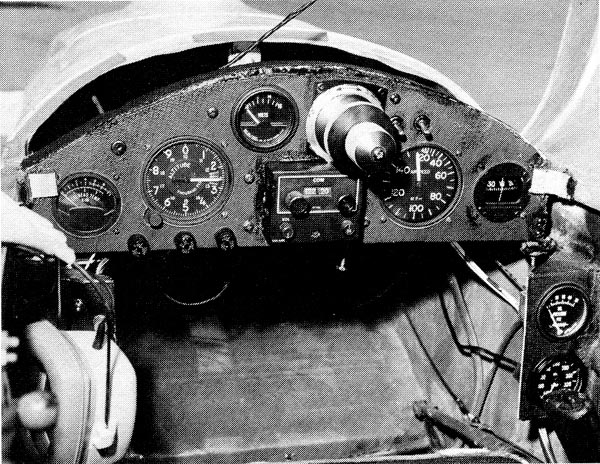 |
| Fig. 6-8. Fig. 6-8. Cockpit installation of the Quickie. Round knob in the center is a temporary installation of a controllable pitch propeller drive. This control would be relocated in production planes since it would be a hazard in case of an off-field landing. |
Many pilots who may have been considering purchasing or building an aircraft look only at the initial purchase price when considering how much the aircraft will “cost” them. This is a fallacy since the owner will usually spend more on maintaining a typical aircraft than he spent to obtain it in the first place.
Most pilots will agree that it is difficult to find a production aircraft cheaper to fly than a Cessna 150. Let’s compare the cost of fuel and oil for one year of a Cessna 150 and a Quickie. We will assume that each aircraft flies 200 hours a year. Since the Cessna burns 6.1 gallons per hour, as opposed to the Quickie which burns 1.5 gallons per hour, the Cessna uses 4.6 x 200 = 920 gallons of fuel more per year than the Quickie. At current prices, that is over $1,700 more per year to operate the Cessna. In addition, the Cessna uses a quart of oil every 10 hours, whereas the Quickie uses a quart every 50 hours.
To overhaul a Cessna 150 engine will cost about $3, 000; to buy a new Quickie engine will cost less than $1,000.
Since the Quickie lacks complex systems (Fig. 6-8), and since the owner of a homebuilt can legally do all of his own maintenance, a large savings is realized in maintenance cost over the Cessna 150 owner who pays about $25.00 per hour shop rate, and maybe $200 to overhaul the carburetor. We all know about the inflated prices of components with “Aircraft” stamped on them. Remember, maintenance costs are proportional to the initial purchase price, not the market value.
ONE PILOT’S OPINION
Wayne Thorns reported on the Quickie in Mechanix Illustrated magazine, copyright 1979 by CBS Publications, used here with permission. In a report titled “A Plane for Under $4, 000,” Thorns said, in part, that the Quickie kit represents the easiest-to-build plane in this country, if not the world. “And it’s complete even to the engine, requiring only paint and a motorcycle battery before you, too, can be up there winging with the birds.”
Moreover, the Quickie is an efficient craft aloft, able to cruise at 121 mph; when you back off to an even 100 mph, she can go 85 miles on a gallon of fuel. Construction time is estimated at 400 hours.
“Flying the Quickie is the most fun you have in the daytime in public without getting arrested,” begins the flight report. And the actual flight is described later in the article as follows:
Line up with the runway, push full throttle, hold slightly aft stick and the Quickie levitates at 53 mph, flying off more or less level and going up like a slow elevator. Acceleration feels similar to that of a small two-place trainer. Takeoff distance is 660 feet at sea level, about normal for small aircraft and slightly less than a 100-hp Cessna 150.
Instructed to climb at 70 mph, we lowered the nose shortly after takeoff to accelerate. The idea was correct, but the Quickie is so much more responsive than the craft we usually fly that we pushed too much forward stick, then too much aft. The effect was an interesting porpoise at about 30 feet—that’s right, 30 feet! —until we worked out the technique of gentle control movements.
Rate of climb is 425 fpm, but there’s no gauge to indicate this. The instruments built into the canopy panel are airspeed, altimeter, compass and voltmeter. Tachometer, cylinder-head temp and oil temp and pressure are on the left. Our test plane had a bell to indicate coordinated flight but it did not agree with the seat of our pants. After a while we ignored it and later on the ground we were advised that our pants were correct.
Once the Quickie levels off, the speed builds slowly behind 100 mph indicated. The advertised cruise of 121 mph true airspeed can be achieved, but we weren’t off on a cross-country trip and didn’t try.
The idea of being strapped into a powered flying machine that weighs little more than the pilot and has the ability to respond instantly to the pilot’s wishes was mind-bending. Never has this pilot felt more in control of his destiny than with the Quickie.
Approach to landing is made between 70 and 75 mph, adjusting throttle as required to reduce speed and maintain glide angle. Contact is made at about 55, tailwheel first with stick full aft. In theory, at least, this is simple. After all, the main wheels are clearly in view on the wingtips, and with a long runway there is no reason to drop the airplane in. A kiss-soft landing should be within the grasp of even a novice pilot.
We goofed slightly, and we were glad that the main gear/canard wing is stressed to 12 Gs. Our drop was only a matter of inches but it felt like much more. The canard took up the shock, we steered carefully with rudder pedals and applied the brakes.
[QBA Editor's note: For some reason the Chapter abruptly switches to Burt Rutan's Choice of engine for the LongEZ. I won't include most of the rest of the chapter except for the following paragraph from Burt Rutan that I hear quoted a lot in other sources.]
EXPERIMENT WITH A CUB—IF YOU MUST
Now, if you have an engine that looks good to you and you really want to prove it out for aircraft use, here’s what you do: fly it! There is no substitute for flight experience. Not in a homebuilt, though! Get yourself a Cub or Champ that is a very forgiving airplane, easy to land safely in a pasture. You are going to make several emergency landings, so plan on it. If things really get bad and you have to plant your test vehicle in the trees, then for the FAA, it’s just another Cub that crashes—not a homebuilt. Also, you can buy another Cub and get your test program rolling again, quickly. If you had used a homebuilt, you would have to build another airplane instead of getting on with your engine development work.
